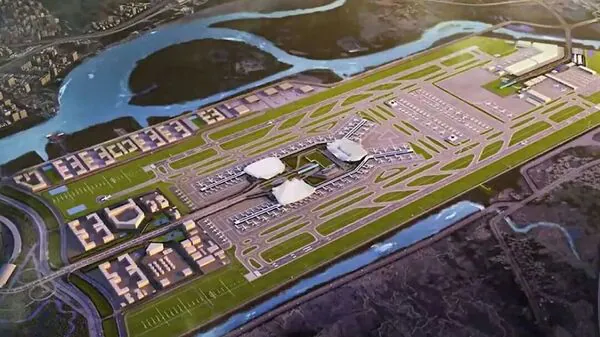Navi Mumbai International Airport Expected To Start With A Bang: What We Know About Flights, Terminals And Capacity
After the elections, the date slipped into 2025 and continued to slip. As we enter the second half of 2025, the airports are yet to see the start of operations. As the new date of September 30 emerges for the possible inauguration of operations, the official Notice to Air Missions (NOTAM) states that the airport is closed for operations until the wee hours of October 1.
Inaugurations and the start of operations also don't go hand in hand, and a date for the start of operations remains elusive, nearly a year after the airport was first supposed to be operational. As is the case with most projects, it's better late than never, and the much-needed capacity for Mumbai is now a matter of weeks, if not months.
While social media has been abuzz with sneak peeks into the terminal showing automated baggage handling, self-check-in baggage machines, large arrival halls and baggage belts, considerable progress has also been made on the airside in the last few months.
Also Read | Get glance of Navi Mumbai International airport ahead of inauguration on Sept 30Navi Mumbai International Airport. (Photo: @dronemanYT/X)
Construction has continued on the airside, with the operator adding bays, while other infrastructure linked to passengers, like terminals and approach roads, is getting ready. The latest Aeronautical Information Publication (AIP) issued for Navi Mumbai airport shows that it has provisions for up to 45 code C aircraft starting October 2, 2025.
Also Read | Why Top Airlines Are Reluctant To Shift To Adani's Navi Mumbai Airport | ExplainedCode C aircraft includes the A320 family and the 737 series, the mainstay of airlines in India. A code C aircraft is one which has a wing span between 24 and 36 meters, as per ICAO (International Civil Aviation Organisation).
There are also about 10 Code E bays, which can accommodate widebody aircraft like the B777, Dreamliners or the A330. These are convertible bays, which means that when a Code E aircraft is handled, there is a reduction in the availability of Code C bays. The airport will also have one Code F gate, capable of handling the A380.
The airport will also start with 14 bays for General Aviation aircraft and a dedicated terminal, which is much larger than the one currently at Mumbai's Chhatrapati Shivani Maharaj International Airport.
When the airport starts operations, it is designed to cater to 20 million passengers annually, which will eventually increase to 90 million passengers.
Mumbai Airport handled 55 million passengers last year. As Mumbai airport works towards a revamped Terminal 1 and closes it for operation, Navi Mumbai airport will see a mix of new movements and flights transferred from the existing airport as it begins operations.
IndiGo, Akasa Air and Air India Express have already committed to a certain number of flights starting from Navi Mumbai airport.
Also Read | Airlines should not be forced to move to Navi Mumbai International Airport: IATA Inauguration & operationalisation are differentThe airport's groundbreaking ceremony was held in 2018, but it was delayed due to the pandemic, among other issues.
Connectivity to the airport remains poor as of now, though there is a plan and work is in progress for multimodal connectivity across the Mumbai Metropolitan Region.
As the official confirmation on the date of inauguration is awaited, operationalisation still has some time.
Goa's MOPA airport was inaugurated in December 2022, while commercial operations began three weeks later on January 5, 2023. For Navi Mumbai, it could take longer or happen in batches, starting with limited hours of operations and expansion thereon.
How streamlined the start of operations is will set a benchmark. It is not often that a large airport begins operations in India. The last time a major city had a new airport was in 2008, when both Bengaluru and Hyderabad transitioned to new airports, thereby closing the previous ones.
Tail NoteWhen fully complete, the airport will have two functional parallel runways, which the existing airport at Mumbai does not have. This will mean a capacity of 90 million passengers a year, just short of what the Delhi airport is currently designed for.
Going by the current commitments published by the airlines, the first phase of Navi Mumbai International Airport seems all set to be full within a year, and it will only be faster if Mumbai Airport's Terminal 1 is closed for renovations and refurbishment.
Legal Disclaimer:
MENAFN provides the
information “as is” without warranty of any kind. We do not accept
any responsibility or liability for the accuracy, content, images,
videos, licenses, completeness, legality, or reliability of the information
contained in this article. If you have any complaints or copyright
issues related to this article, kindly contact the provider above.
Most popular stories
Market Research

- New Cryptocurrency Mutuum Finance (MUTM) Raises $15.8M As Phase 6 Reaches 40%
- Bydfi Joins Korea Blockchain Week 2025 (KBW2025): Deepening Web3 Engagement
- Yield Basis Nears Mainnet Launch As Curve DAO Votes On Crvusd Proposal
- 0G Labs Launches Aristotle Mainnet With Largest Day-One Ecosystem For Decentralized AI
- Ethereum-Based Defi Crypto Mutuum Finance (MUTM) Raises Over $16 Million With More Than 720M Tokens Sold
- Fintech's Gender Gap In Focus: Drofa Comms' Women Leading The Way Joins Evolvh3r's She Connects At TOKEN2049






















Comments
No comment